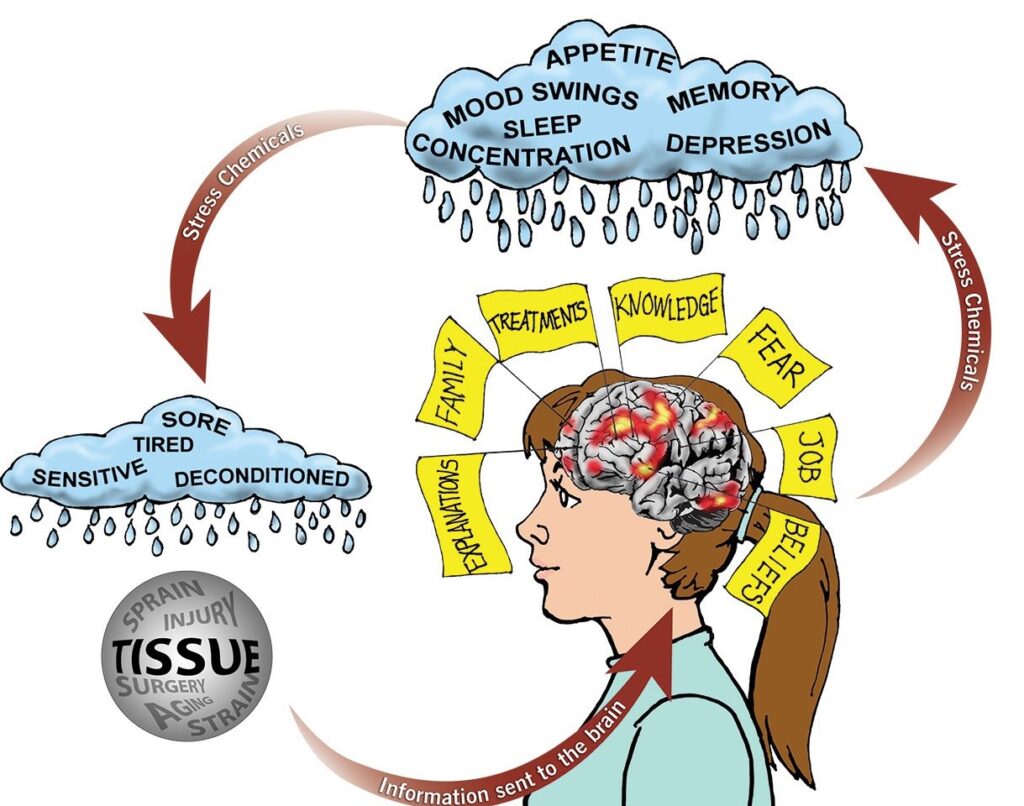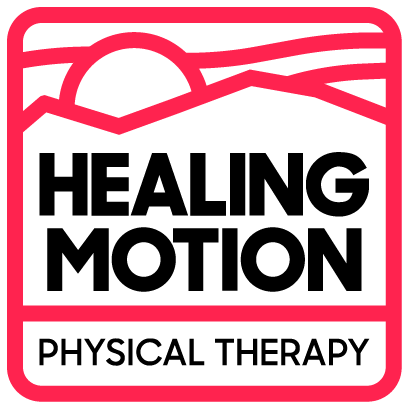Pain is a huge part of the human experience. There’s a saying, “Two things are certain in life, death and taxes.” Well, we would argue you can add pain to that list!
We will all experience pain in life. Physical and emotional. One in four people experience chronic pain throughout their life. The reality is that while pain usually starts out as a tissue injury, rarely does your pain “heal” and go away as quickly as your tissues actually heal. Hence, we still have “hurt”, but we no longer have “harm” of the tissues in our body. The purpose of this blog is for you to better understand “hurt vs. harm” when you have pain and to empower you to not let pain take away your joy in life.
So, you’re saying, my pain is all in my head? Yes, but NOT in the negative context that you’re making it up. You ARE NOT making up your pain. Your brain IS generating your pain, that’s how pain works, as you will soon learn, but your pain is real, it’s just the calibration of your brain’s alarm system for your pain may need some refining. If you take nothing else from this resource, please remember the following:
- All pain is pain.
- All pain is real.
- All pain can change.
This Resource will cover:
- How Does Pain Work?
- Tissue Injury Healing Process
- When Pain Goes Wrong?
- Chronic pain cycle
- What to do when you have pain
- How to keep your joy in life > pain
- How to reduce your risk for future pain and injuries
For other helpful pain resources, check out our pain resources here.
How Does Pain Work?
Since this resource has some length to it, if you have TLDR syndrome, feel free to take a look at our Pain Education YouTube playlist to learn more about pain! We encourage you to read along below at some point, because we do think it will change how you view pain for the better!
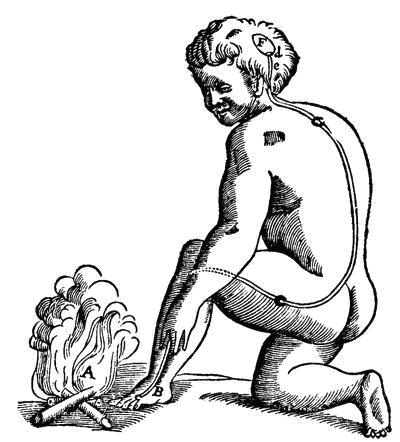
One of the more notable first depictions of pain was drawn by Rene Descartes in the 17th century. Pain was described very simply. When a painful stimulus creates tissue damage, your nerves tell your brain, and you experience pain. That’s it. The problem with this is it’s vastly incomplete. Yes, that is the primary reason we have pain the first time with an injury, but pain can then linger for other reasons than tissue injury.
As you can see below, pain is much more complicated. It involves all of the factors described below. The more stressors we have in all of these other areas, the more they fuel the pain fire.

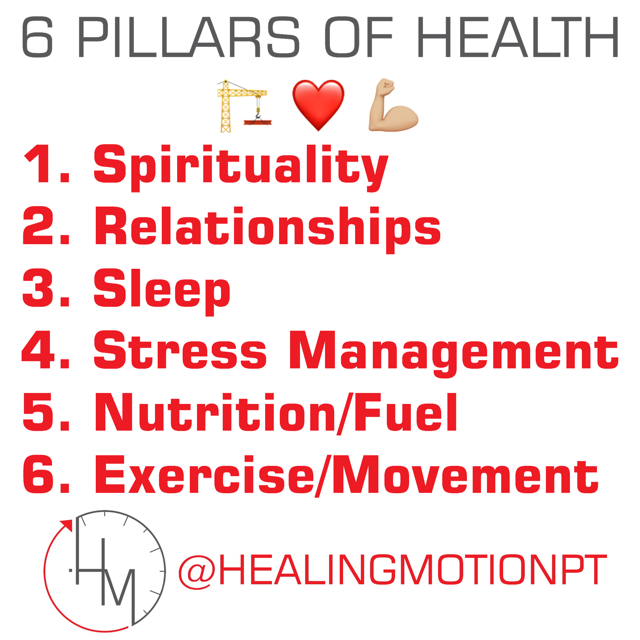
Most of those factors above, can be simplified into our 6 Pillars of Health. For more info on how to balance and improve upon your 6 Pillars of Health, check out our blog on it.
The Tale of Two Nails
The best way to paint the picture of the relationship of tissue injury and how our thoughts, emotions, and overall 6 Pillars of Health interact to generate pain or minimize pain is two separate case studies involving nails.
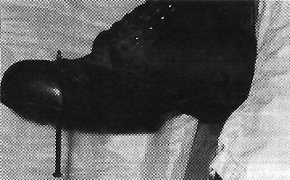
The First Nail Tale (1): In 1995, a British construction worker jumped down from a ledge and looked down to see the 6 inch nail as shown in the picture, sticking through his boot. He had immediate severe pain and was rushed to the local emergency department. Upon arrival, any small movement of the nail gave him such severe pain that they sedated him with fentanyl and midazolam. Upon carefully removing his boot, it was found that the nail was in fact between his toes and there was no tissue injury at all to his foot.
He had SEVERE pain with ABSOLUTELY ZERO TISSUE INJURY. His pain was pain. His pain was real. But, his pain was driven by fear and context rather than tissue injury.

The Second Nail Tale (2): In 2007, a case study was released describing a construction worker who had unknowingly shot a 4 inch framing nail into his head as shown in the image. He had sworn he saw the nail go into the wall and thought his discomfort was just the result of the nail gun kicking back into his face. He felt like he just had a nagging tooth ache and 6 days later went to see his dentist. His dentist took an x-ray and only then was the nail found.
He had minimal pain with SEVERE TISSUE INJURY AND THREAT TO HIS LIFE! His mild pain and attributing it to a simple tooth ache was driven by his environment, context, and lack of awareness of harm rather than actual significant tissue injury and potential life threatening harm!
Normal Pain Response
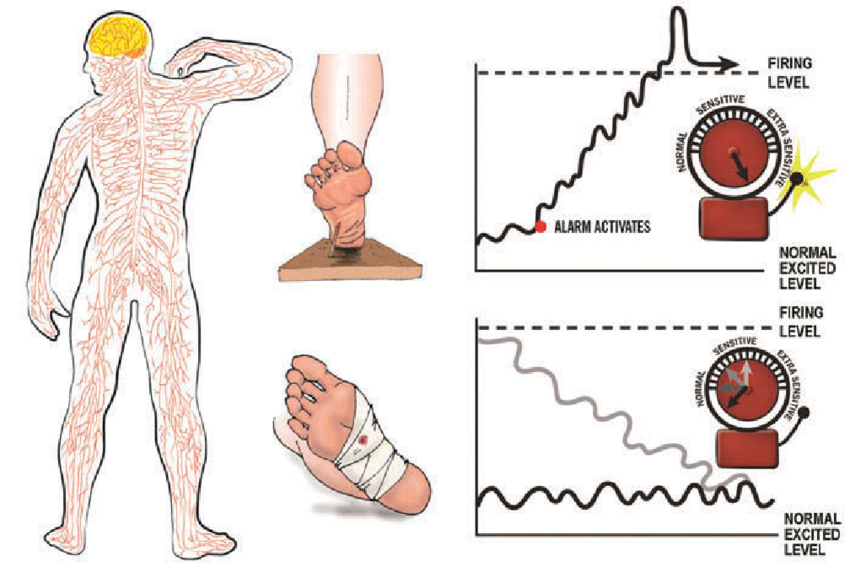
The picture to the side or below shows a normal pain response. This is essentially what Descartes depiction above demonstrates. You step on the nail, you have pain. Once your body realizes you’re no longer stepping on a nail and your body starts to heal, the pain calms back down.
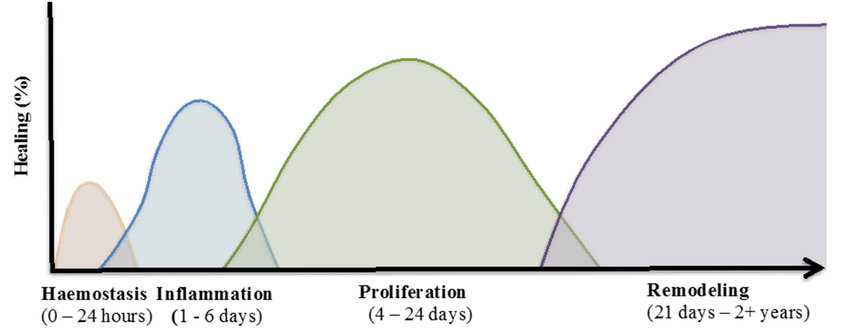
This coordinates well with the normal healing process of tissues. This picture is specific to our skin healing. The proliferation phase can last up to 6 weeks for muscles, tendons, ligaments, etc, but you get the picture, our body heals quickly. The remodeling phase is just the new scar tissue getting stronger and should not cause pain, but all that others stuff from above can still contribute to pain.
Some Tissue Wear and Tear is NORMAL! “Wrinkles on the Inside”
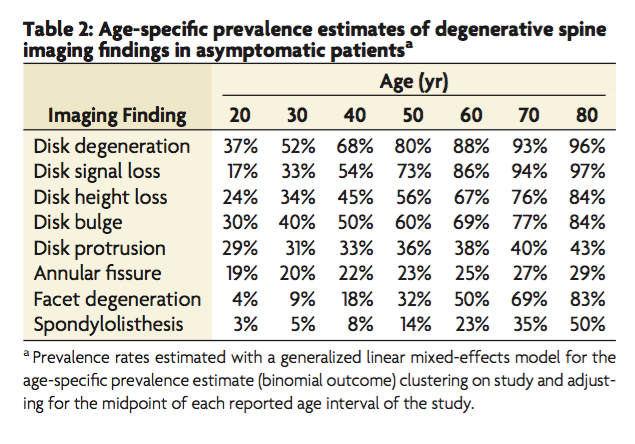
This is a good time to bring up, that some tissues do wear and tear over time, but that is normal! Just like we get wrinkles in our skin, we get “wrinkles” in our tissue, they age! That said, that does NOT mean you have to have pain. Brinjikji, et al(1) did an excellent systematic review that shows us changes in our spine discs are NORMAL in people WITHOUT pain. Just because you have some tissue wear does NOT mean you have to have pain.
Now, imagine, you already have some of this wear and tear, you hurt your back, your pain lingers, you get an image, doc says you have “disk degeneration” and now you think you’re stuck with this pain forever. Absolutely not! If you’re 50, you and 3 out of 4 of your friends WITHOUT pain have it too!
When Pain Goes Wrong and the Chronic Pain Cycle

Chronic pain is largely the result of our pain alarm system getting out of whack, rather than that we have ongoing tissue damage. This is not always the case. Yes, you can lose enough space in your spine where your bone is compressing your nerve. This will result in weakness and needs to be addressed surgically. That said, by and far, the majority of chronic pain is more hurt, but not harm. Meaning, you have a lot of pain, it’s real pain, but it’s not because you have a tissue in your body that is still harmed. Did it harm initially, sure, but look at that healing process above. It has healed, just your pain hasn’t.
The alarm system analogy works perfect with this. It’s like you had an alarm system on your house. Someone broke in, alarm system went off, but they still got away with a lot of stuff. That hurts. You lost your grandma’s necklace that meant a lot to you. You can’t replace that. Well, you’ll show them! You buff up your alarm system. Now, someone sets foot in your front yard, your house alarm goes off. The only problem is, 99% of the time it’s going off, there’s no threat. Everything in your house is back to normal (other than grandma’s necklace), but your alarm keeps sounding.
This is chronic pain, in a nut shell. Your alarm is really going off. You really do have pain! It hurts! But, no one’s breaking into your house. Your tissues are not injured or harmed. If you put the same exact pain in someone else, they would feel the same exact pain! The problem is, you put the same pressure on that patient’s body, their alarm system doesn’t go off, but yours does! So, they don’t have pain, but you do! Good to know, what do I do to fix my alarm system?
The first thing is recognizing hurt vs. harm. The second thing is going back up to those pictures and the 6 pillars of health and try to address all those things that can be feeding the fire. The first step is awareness. You’re back with your alarm system going off all the time. If you think someone is actually breaking into your house every time your neighbor’s dog is peeing in your yard or amazon is dropping off a package, you’re going to go crazy. On top of that, you might actually buff up your alarm system MORE and make things even worse! The cycle feeds itself.
However, if you recognize that most the time the alarm is going off, it’s just as loud as always, but there’s no harm to your house, you are much more calm and you can take action to back your alarm system back down to just go off when someone opens the door.
Okay, sure, I know how to do that with a house alarm system, but how do I do that with my body’s pain alarm system?
What to do when you have pain
1. Rule out any Red Flags
First and foremost, make sure that your pain is not the result of a life threatening or future function threatening emergency. These would primarily be heart attack, stroke, spinal cord injury, an excessive bleeding issue, fracture (broken bone), dislocation, etc. There are far too many red flag signs and symptoms to list here. If it’s obvious, call 911 immediately. If it’s suspicious, but not obvious, call your primary care physician or seek immediate care at the ER or urgent care. If it’s not this serious, move on down the list.
2. When in doubt, have it checked out
If you’re not sure if your pain issue is something that will gradually improve, see a professional. I’m biased, but I would recommend seeing your Physical Therapist first for any pain issue. Pain problems are not medical problems. Physical Therapists are the experts at identifying the source of your pain, why you’re having it, and what to do about it. They are also experts at identifying when you should see your Primary Care Physician for further evaluation of more serious injuries or for other things masking themselves with pain such as cancer. It’s more and more rare that you would need a referral to see your PT. Call your PT office and they can run your insurance to confirm. As PTs, we do then still communicate your care with your PCP to keep them in the loop.
If you think your pain is something you can self manage, proceed on down.
3. POP Pain Management/Injury Strategy
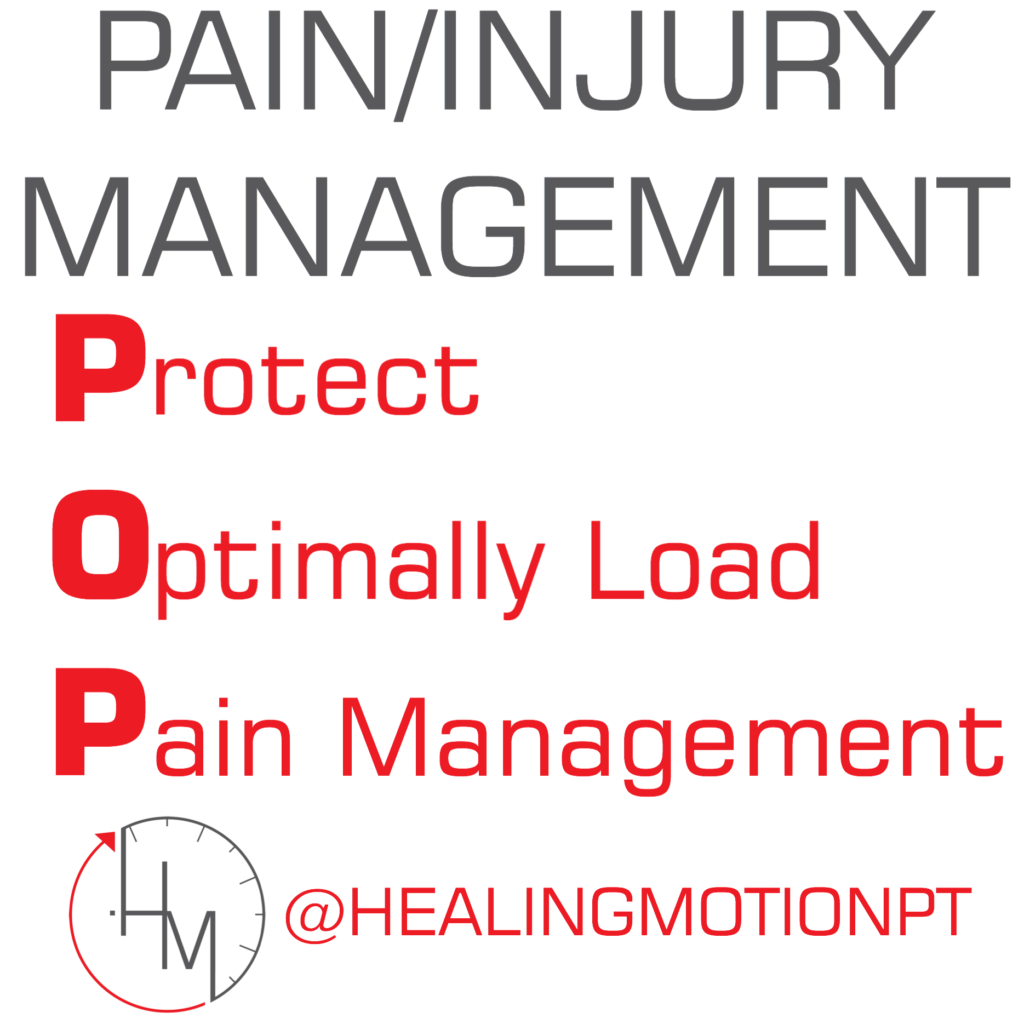
This is the best way to manage pain and improve as fast as possible. Rather than RICE: Rest, Ice, Compress, Elevate, we recommend POP: Protect, Optimally Load, Pain Management. Check out our blog on this for details on how to best to this and then come back and work on down the list.
4. LTA: Load Tolerance and Abilities
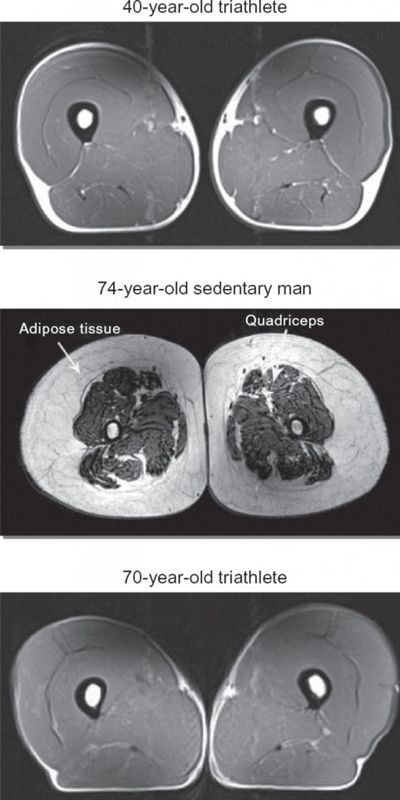
1. Load Tolerance
This is simply considering how much load and stress a tissue can tolerate. Refer back up to the healing process graph above to see how the tissue gradually increases it’s tolerance as healing occurs. The big thing to know is that we can absolutely control this. Tissues respond to the load placed upon them. The more we steadily load a tissue, the more it strengthens to tolerate more load. The picture to the side or below is a perfect example of this. These are cross sectional images of thighs of 3 different individuals. As you can see, less activity leads to less muscles. It doesn’t take a rocket scientist to tell you which pictures will handle more load. A lot of weakness with aging is because of deconditioning, not age.
How do you apply this to pain and healing? Steadily load the tissues. Pick a starting point with the “optimal load” mindset in the POP acronym, and gradually do more. The cool thing is that 74 year old sedentary man can make those muscles bigger and the fat less, if he puts the work in. The body responds to the loads placed upon it.
2. Abilities
Now, just because your tissue is healing and getting stronger doesn’t on it’s own clear pain or prevent you from risk for future pain. You must consider your abilities. Can you move through full range of motion with proper control? Can you do that with more load/weight? More speed? You need to train your body to have the ability to do what you want it to do. The more you can move with proper form adding more weight and speed, the more resilient you are to pain and injury. Liv does an excellent job in the video below showing us how to fight for proper form and depth with a single leg squat, fighting the knee from wobbling in.
This is not appropriate for everyone. Start with a double leg squat, progress that with depth and adding weight, work into a lunge and do the same, and then a single leg squat.
So, you need the load tolerance, but also the ability to move well to improve from injury and reduce risk for future reoccurrence.
5. Long Term Plan/Maintenance
- Remember Hurt vs. Harm
- POP Recovery Method
- Realistic Pain Expectations
- Always strive for no pain
- Joy with activities > pain
- Ultimately, if you can’t clear your pain, at least work to be able to have joy doing the things you want to do. You should never just accept a “you should never run again” statement from anyone. You can work back into it if you want and if the joy is better than any pain you have, great! Pain is a pain problem, not a medical problem.
- Use it or lose it
- You have to challenge it to change it
- Think of building a savings account with your strength and mobility just like you would with finances
- Increase Load Tolerance and Abilities
- The body responds to the loads placed upon it
- Muscles adapt to protect joints
- Establish full range of motion with good form, load more through that full range and add speed
- Remember ALL the 6 Pillars of Health
- Live long, die fast
- This is a concept that if you have all aspects of health dialed in you can live long doing the things you want and eventually you will die, but it will be more likely to be an event that happens quicker rather than getting sicker over time (yes, there are some exceptions to this like cancer)
Summary/Takeaways
- Pain is a pain problem NOT a medical problem
- If you need help, see your Physical Therapist for your pain problem
- Chronic pain is a pain issue NOT a tissue issue (usually)
- Hurt vs. Harm
- Refer up to our 5 steps of what to do when you have pain
- Rule out, if doubt check it out, POP, LTA, Long Term Plan
- Work to have joy with activities be greater than pain
- Work to reduce your future risk of pain and injury
- Understand that pain is a good thing! We don’t want to keep burning our self or stepping on the nail! Be okay with pain, understand it, work through the process to decrease it and reduce your risk for it as much as possible!
- Keep trying to get better at your 6 Pillars of Health every day
Hope the above helps make pain less fearful and obscure and helps put it in a box you feel like you can work with. Remember, Physical Therapists are the experts at treating pain problems. If you’re local, you can schedule with us at Healing Motion here. We also do have more pain resources here.
Happy Pain Managing!
Dr. Dane Happeny, PT, DPT, OCS, CF-L1
Doctor of Physical Therapy
Board Certified Orthopedic Specialist
CrossFit Level 1 Trainer
References
- Fisher JP, Hassan DT, O’Connor N. Minerva. BMJ. 1995; 310:70. doi: https://doi.org/10.1136/bmj.310.6971.70
- Dimsdale JE, Dantzer R. A Biological substrate for somatoform disorders: importance of pathophysiology. Psychosom Med. 2007; 69(9): 850-854. doi: https://doi.org/10.1097/PSY.0b013e31815b00e7
- Brinjikji W, et. Al. Systematic literature review of imaging features of spinal degeneration in asymptomatic populations. Am J Neuroradiol. 2015; 36(4): 811-816. doi: 10.3174/ajnr.A4173.
Photo Credits:
- https://www.researchgate.net/figure/Descartes-model-of-pain-perception-24-The-Cartesian-perspective-dominated-the_fig1_279684516
- https://www.semanticscholar.org/paper/Theories-of-pain%2C-up-to-Descartes-and-after-what-do-Burmistr/d3d72077a4cc5bf41eb523fa9d73259e610f818d
- https://www.amazon.com/Pain-Neuroscience-Posters-876SET-Adriaan/dp/1942798040
- https://straightshothealth.com/what-do-pain-fire-have-in-common-and-why-it-matters/?hvid=3vZakQ
- https://www.researchgate.net/figure/Metaphorical-explanation-of-the-nervous-system-as-an-alarm-system-during-nociceptive_fig1_304573069
- https://www.researchgate.net/figure/Wound-healing-process-The-normal-tissue-repair-process-is-comprised-of-continuous-and_fig1_316640642
- https://sptny.com/medical-tip/pain-your-bodys-alarm-system/
- https://www.amazon.com/Pain-Neuroscience-Posters-876SET-Adriaan/dp/1942798040


